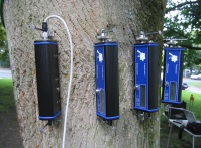| Message: | Measurement system for pulling tests on trees
The tree pulling test is performed to get information about the breaking stability of the trunk and the stability of the roots. It is used to assess a tree’s stability with regard to stem fracture and uprooting precisely and non-invasively.
In a pulling test, a load (substituting for the wind) is exerted on a tree using a winch and a steel cable. The reaction of the stressed tree under this defined load is measured with high resolution devices (elastometer and inclinometer), and the data obtained are compared with those of sound trees. The major components to be considered in such calculations are the wind-load (the surface of the load-bearing structure, tree height, etc.) and the material properties of green wood.
The TreeQinetic System is designed to collect data during tree pulling tests. The complete system consists of at least:
One Forcemeter that measures the pulling force.
At least one Elastometer that measures alterations in length of the marginal fibres
At least one Inclinometer that measures the inclination of the tree.
Evaluation software ArboStat (http://www.tree-consult.org/)
Advantages
• Easy, wireless measurement and continuous data transmission
• User can calculate results autonomously using the ArboStat software supplied by http://www.tree-consult.org/
• Easy-to-understand graphical results
• Direct information about the breaking stability of the stem
• Direct information about the stability of the root system
The tree pulling test was developed by WESSOLLY and SINN at the University of Stuttgart in the mid 1980’s.
Specifications of the TreeQinetic Components
Elastometer
Resolution: 0,1 µm
Measuring range: +/- 2 mm
Accu capacity: ~ 20 h bei 20°C (radio on)
TreeQinetic Elastometer @ work
Inclinometer
Resolution: 0,005°
Accuracy: 0,005°
Measuring range: +/- 15°
Accu capacity: ~ 20 h bei 20°C (radio on)
http://www.channelinstruments.com/v_1/525.aspx |
 my account
my account
 log out
log out
 my account
my account
 log out
log out
